 ..
.. ..
.. ..
.. ..
.. ..
.. ..
.. ..
.. ..
.. Ponton Specialties
Ponton Specialties
35 photos below optimized for
800 x 600 screen resolution 619KB
contributed by MB
Enthusiast`s Pages webmaster
Of course you Ponton-lovers know all the "normal" versions of these
legendary Mercedes-Benz models.
But do you know the special versions, the crash testing and how these
fine cars were built?
If you don't, you're on the right page. Here you get info and photos
you will see nowhere else on the whole internet.
Guaranteed.
So let's begin with the Ponton specialties. There are station car,
pick-up, cabrio, taxi, rally car, police car, ambulance
and - yes! - hearse.
But by extensive crash testing Mercedes-Benz did its very best to avoid
the use of the hearse-ponton.
That's why we come to the crash testing first.
Ponton Crash Testing
Mercedes-Benz was the car manufacturer which first of all took great
attention of the security of its vehicles and thus did
extensive crash-testing.
 |
Photo from reference #5, page 8. The text says:
"For the centennial of the Automobile the German Museum
in Munich in 1986 crashed this twenty year old 220S to demonstrate
Bela Barenyis security cell."
Obviously the book is wrong with the age of this 220S as it was built
from 1956 to 1959. Most possibly they meant that the car is thirty
years old.
Bela Barenyi was the genius of car security: He invented many things
which we nowadays take as a given standard. |
 |
Photo from reference #1, page 49. The text says:
"In the courts of the big car manufacturers (shown here Daimler-Benz)
the test cars do gather which with experiments for higher driving safety
outer form and inner life had to give."
Until now around 1200 cars have been used by Mercedes-Benz for crash
tests.
I know you Mercedes-Benz enthusiasts must be very strong while watching
this photo and trying not to burst into tears with all these lovely cars
destroyed! |
This photo must be from 1970 as the figures on the cars first denote the
year and secondly the number of the crash test
for that particular year - note the car with the "69/45" on the trunk,
it's a MB 600 SWB W100. The number of the year on the ponton can not be
seen but as the 600 is #45 of 1969 the pontons #50 must be from 1969, too,
as the highest number from 1970 is the relatively low 7 on the SL
W113.
As the numbers on the ponton are painted head up it must have been
used for a roll over test (and no, I don't say anything about the W168
aka A-class now).
Very interesting that many years after the end of the production cars
were tested - for comparison with then actual models?
Ponton Production at Sindelfingen Factory
Production was somehow different from today: No robots at all, the
quality of the cars mainly depending on the knowledge of the workers and
the accuracy they put into their work. Note how they welded the body together.
 |
Photo left from reference #4, page 29. The text says:
"Body manufacturing in Sindelfingen. Robots didn't
substitute manual work."
These skilled workers were responsible for the outstanding quality of
the Pontons - and they did a really great job! |
.
Photo on top from ref. #4, p. 54. The text says:
"Cars from the pre-series of the 220Sb (outer left in the photo) being
transported to the paint
booth on the same line as the phasing out 220S.
The photo is from summer 1959."
Photo on bottom fr. ref. #4, p.21. The text says:
"190 bodies on their way to be painted
(Sindelfingen factory)." Detail from original photo only. |
Photo from reference #4, page 13. The text says:
"The 180 being built. The body is set onto the chassis."
This process is also known as "marriage". Interesting detail that the
front fenders have not been added to the body yet.
|
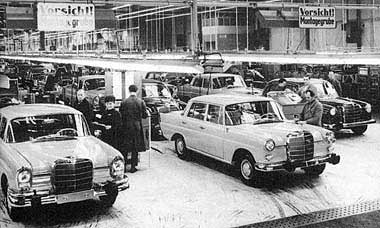 |
Photo left from reference #4, page 59. The text says:
"From end of the production line Sindelfingen 1962.
A 180c at the back, a 190c and a 220Sb in the foreground."
This is only a detail from the original photo. |
Ponton Design Studies
In the beginning it was not clear the W120 would get a ponton-body
which is proven by these studies.
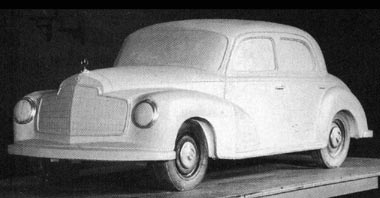 |
 |
Photo from reference #6, page 22. The text says:
"This curious suggestion luckily was not gotten
round to the W120 customers". |
Photo from reference #6, page 22. The text says:
"Curiosity: The Mercedes stylists did practice
with a SL-like front-mask but it was dismissed
very soon". |
 |
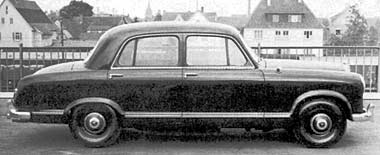 |
Photo from ref. #6, page 22. The text says:
"1:5 scale model with fenders emphasized around wheels and pulled-down
bottom edges of windshield".
Note the turn signals below the headlamps. |
Photo from ref. #6, page 22. The text says:
"1:1 scale model of W120: Divided windows and fenders emphasized around
wheels."
Note with both studies esp. rear fenders partly cover wheels. |
Ponton Cabrio Prototype
This is the one Ponton variant which never made it into production.
 |
Photo from reference #6, page 26. The text says:
"After the cabrio - which had been forced until prototype stadium -
went away from the planning the large-scale cloth-sunroof was the only
alternative for fresh-air fans."
Note the shortened wheelbase.
As there were two variants developed this is variant A - variant B
had the normal wheelbase. |
 |
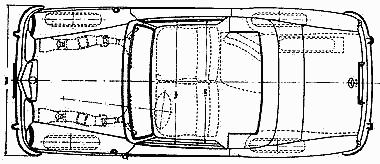 |
Drawing from ref. #8, page 452. The text says:
"Type 180 cabriolet A draft 1953 (not realized)".
This drawing shows the above photographed
cabrio with the shortened wheelbase and a rear
seat for one (!) passenger. |
Drawing from reference #8, page 452.
You can clearly see the one back seat, the passenger to sit diagonally
with his legs behind the driver's seat. |
 |
Drawing from reference #8, page 452. The text says:
"Type 180 cabriolet B draft 1953 (not realized)."
This variant has the normal wheelbase and four seats. |
Pontons Disguised for Road Testing
For the necessary road testing on public roads the Pontons were disguised
so people and especially photographers spotting them could not get the
full impression.

Photo above from ref. #6, p. 22. The text says:
"With the W120 the testing engineers busily
practiced in disguise and deceive".
Photo right from ref. #6, page 23. The text says:
"Summer testing at Grossglockner: W120
prototype with Citroen front-mask, Rudolf
Uhlenhaut". |
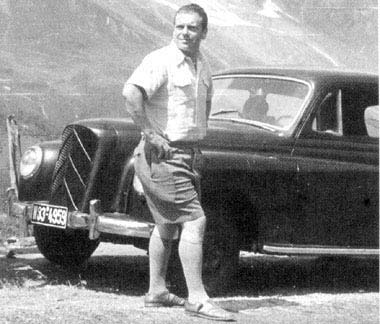
|
Special versions
Now that you've got an idea of the production of the Pontons and of
some design studies we come to the "special versions"
which means these cars were not used for private every-day driving
but for special purposes.
.
Ponton Station Wagons
Today its natural for Mercedes-Benz to offer station cars ex-factory.
In the Ponton era it was not and so independent
companies manufactured them although the cars were sold at the official
Mercedes-Benz dealerships.
The most important body builders were the German companies Binz &
Co. from the small town of Lorch, some 30 km
east of Stuttgart and Christian Miesen in the former German capitol
Bonn.
 |
 |
Photo from ref. #7, page 224. The text says:
"Type 180 and 180D station wagon (body by
Binz) 1954 - 1959". |
Photo from reference #7, page 224. The text says:
"Type 180 and 180D station wagon (body by Miesen)
1954 - 1959".
This station wagon version with the higher side windows was extremely
unusual with non-ambulances. |
 |
Photo from reference #4, page 165. The text says:
"Station wagon on the base of 190 Diesel, 1958. One sees these cars
very seldom today".
Judging by the other cars in the photo it was shot 1973 or later.
Note the car has two doors only and no middle and rear
side windows. |
Ponton Ambulances
The ambulances were special variants of the station wagons.
 |
 |
Photo from ref. #8, page 454. The text says:
"Type 180, 180D, 190, 190D ambulance body
by Binz 1954 - 1962 (also available as station
wagons)".
Car has the higher side windows.
Author Oswald is wrong: The car in fact was
built by Miesen as can be seen by the little
badge down on the A-pillar on the front fender. |
Photo from reference #8, page 454. The text says:
"Type 180, 180D, 190, 190D ambulance body by Miesen 1954 - 1962 (also
available as station wagons)".
Car has the normal side windows.
As Oswald mixed-up things this car in fact is built by Binz. |

Photos from reference #4, page 165.
Ambulance car built by Miesen.
Note the storage of the spare tire and the normal
front door windows and the higher side
windows in the middle and rear. |
|
 |
Ponton Pick-up
 |
Photo from reference #6, page 26. The text says:
" The platform-version changed the 180 into a good-natured-reliable
workhorse".
This version is more than extremely rare.
I have heard that especially in South Africa some do exist. |
Ponton Hearse
 |
Photo from reference #4, page 167. The text says:
"190 hearse from 1957, bodywork by Binz."
As can be seen by the writing on the driver's door the car was owned
by an undertaker in the German city of Giessen. |
Ponton Police Cars
The police 190b had a top speed of below 135 km/h (83 mph) and the
220S of below 160 km/h (99 mph). But in the Beetle-era, when a 1958 beetle
had a top speed of 112 km/h (69 mph) this was sufficient.
 |
Photo from reference #2, page 105. The text says: "Radio patrol car
Mercedes-Benz 180 b 4 cylinder 1,9 litre 68 hp 1959-1961 of the motorized
police in (the German town of) Trier ."
Due to their price tag MB`s as police cars were relatively rare, common
that days were VW Beetles: The text besides a VW Beetle on page 81 in this
book says that in 1972 the police had some 8.200 VW`s. |
 |
Photo from reference #5, page 61. The text says:
"Interceptor. A martial-armed highway patrol car of the 220S type from
Stuttgart Police."
Note the lamp-like case on the front top of the right fender.
In the pre-videotape era it housed an additional tach. When the police
followed traffic offenders both cameras mounted in the top middle of the
windscreen were released simultaneously, the left one photographing the
offense and the right one the outside tach for court-proof documentation
of the speed.. |
Ponton Taxis
Ponton taxis were on duty around the world. They greatly contributed
to the Mercedes image at a time when most people not only in Germany couldn't
afford a private car at all.
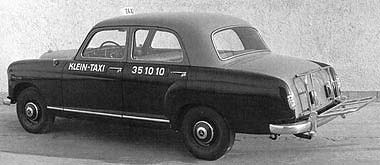 |
Photo from reference #3, page 161. The text says: "Two-colored taxi
from the Mercedes-Benz 180 D type here still in the version with no vent
windows in the front doors as it came onto the market from April 1958.
The photographed car with the bag bridge on the rear was used as taxi
in Austria."
Interesting to have added a thing like a bag bridge (German word is
"Kofferbruecke") to the not that small trunk... |
 |
Photo from reference #4, page 36. The text says:
"A fleet of 180D of a Basel taxi company".
Interesting the same cars as from the above photo now declared to be
used in Switzerland...
The writing "Klein-Taxi" on the front door either means
small taxi (which I think) or denotes the last name of the owner
of the taxi company. |
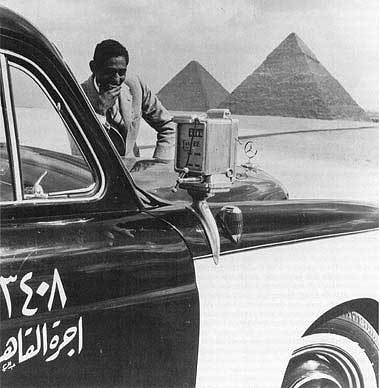 |
 |
Photo above from reference #3, page 337. The text says:
"In the scorching heat, too, here at the pyramids of Gizeh in Egypt,
taxis with the star on the hood did their job." The photo from the year
1958 shows a Mercedes-Benz of the 180 type.
Photo left from reference #3, page 326. The text says:
"In Egypt, too, taxi companies knew to appreciate the tenancy and reliability
of
the Mercedes-Benz type 180 as a taxi" - the photo with the proud cab driver
is from 1958. |
|
The colours for taxis in Egypt were stipulated by the authorities as other
photos of Egyptian taxis from other manufacturers show the same colour
combination.
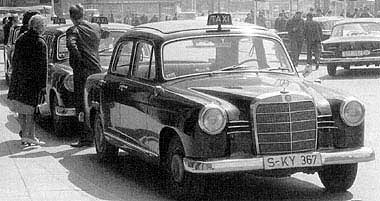 |
Photo from reference #3, page 162. The text says:
"Mercedes-Benz 190D, photographed in the version with wide radiator
and without bumper guards (produced from 1959 to 1961) - one of the most
solid taxi cabs of its time".
Indeed it was.
In Germany - like in Egypt - the colour of the taxis was stipulated:
Until the early 1970`s it was black, the Mercedes-Benz colour code is 040.
As can be seen from the license plate this photo has been shot in Mercedes'
hometown of Stuttgart and the car has the big cloth-sunroof which was rare
with taxis.. |
Ponton Rally Cars
Pontons really could have been faaaaaaast and even with the diesel
engine they were used for rallies!
 |
Photo from reference #4, page 68. The text says:
"The 219 of the team Fritschy/Ellis at the East African Safari Rally
1958." This photo is a detail only of the original.
The first name denotes the driver, the second name the co-driver. The
Kenyan Fritschy/Ellis won the hardest rally of the world, the East African
Safari, twice - 1959 and 1960.
The predecessor of this rally, the East African Coronation Rally, which
went over 5300 kilometres of unsurfaced roads through Kenya, Uganda and
Tanganyika, was won in 1958 by Manussis on another 219. |
 |
Photo from reference #4, page 34. The text says:
"Algiers Cape Rally 1959. Winner Karl Kling at the start on the wheel
of a 190D."
Yes, its a DIESEL! I bet its the slowest rally car the famous Karl Kling
ever drove. The OM 636 (OM = Oilmotor, thus running on diesel) is a very
legendary engine which was not only used for the Pontons but for the Unimog,
the 319-series mini truck and mini bus as well as stationary and ship engine.
It remained in production until 1969 - eight years after the Ponton production
ended. |
References (all in German language):
1) Auto by Muench and Pugmeister published by Carl Habel Verlag,
Darmstadt, Germany 1973, no ISBN
2) Die Kraftfahrzeuge der Polizei und des Bundesgrenzschutzes
(The cars of the police and the Federal Border Guard)
written by Werner Oswald published by Motorbuch
Verlag, Stuttgart, Germany, 1st edition 1974, ISBN 3-87943-332-1
3) Taxi - Das mobilste Gewerbe der Welt (Taxi - The most mobile
trade of the world) written by Ulrich Kubisch published
by Museum fuer Verkehr und Technik Berlin and Nikolaische
Verlagsbuchhandlung, Berlin, Germany 1993,
ISBN 3-87584-489-0
4) Mercedes-Benz Automobile Band 4 Vom 190SL zum 300SEL (MB
Automobiles Volume 4 From 190SL to 300SEL)
written by Heribert Hofner published by BLV Verlagsgesellschaft
Muenchen Wien Zuerich, Munich, Germany 1981,
ISBN 3-405-12604-5
5) Die S-Klasse von Mercedes Benz - Von der Kultur des Fahrens
(The S-Class from MB - From the culture of driving)
written by Heribert Hofner published by Bleicher
Verlag, Gerlingen, Germany 1993. Reprinted by Bechtermuenz Verlag,
Augsburg, Germany 1997, ISBN 3-86047-589-4
6) Motor Klassik 10/1993 monthly classic car magazine published
by Vereinigte Motor-Verlage GmbH, Stuttgart, Germany
7) Deutsche Autos 1945-1975 (German cars 1945-1975) written
by Werner Oswald published by Motorbuch Verlag,
Stuttgart, Germany, 10th edition 1985, ISBN 3-87943-391-7
8) Mercedes-Benz Personenwagen 1886-1986 (MB passenger cars
1886-1986) written by Werner Oswald published by
Motorbuch Verlag, Stuttgart, Germany, 1st edition
1984, ISBN 3-87943-976-1
Text and background image design by MBEP webmaster
Well folks, that's the end of our little tour of the Ponton specialties.
Hope you had a pleasant time, but now its time to go back to where you
came from:
. Return
to Ray Ilich`s Ponton Web Page
Now run by Jeff Miller.........
....... ............
Return
to MB Enthusiast's Pages
| Last revised technically: June 7th 2001. |
 ..
.. ..
.. ..
.. ..
.. ..
.. ..
.. ..
.. ..
..
©1998-2001 by
MBEP webmaster This is a private, non-commercial home page. For detailed disclaimer
click here
This is a private, non-commercial home page. For detailed disclaimer
click here


































